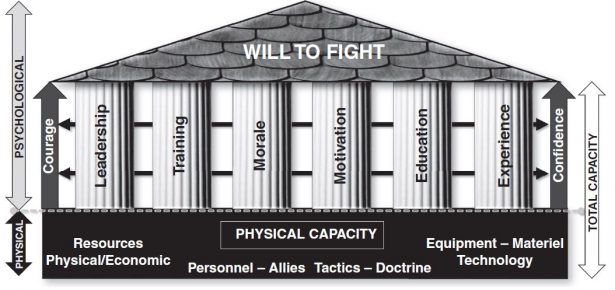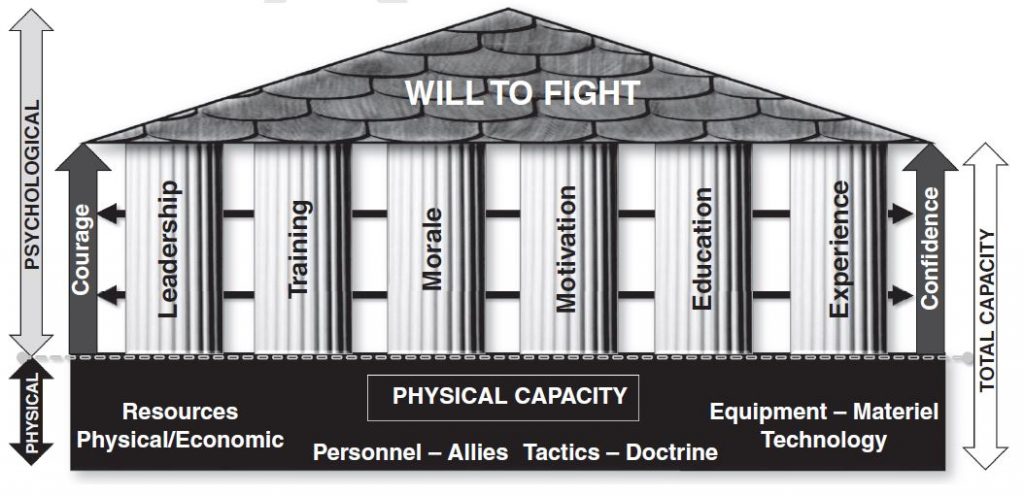
America’s hasty extrication from its war in Afghanistan was anything but smooth, and now the world’s leading superpower’s two-decade misadventure there has ended with a shocking, humiliating defeat. Even as the world contemplates the implications of this seemingly improbable outcome, the post-mortem proceeds in earnest. What went wrong? After two decades of nation building, a trillion US dollars, 23,000 US and nearly half-a-million Afghan casualties, and aggressive recruitment and training, how is it possible that, even before the US was able to complete its withdrawal, the Taliban rule Afghanistan? What factor is most responsible for losing this war: corruption, inadequate resourcing, external interference, nebulous policy, cultural dissonance?
There are plenty of wordy opinions, but as with many problems, consulting a model of the dynamics at work can help us visualize what is actually occurring. Two key elements of the Unified War Theory (UWT)—introduced in my forthcoming book, The New Art of War: The Origins, Theory, and Future of Conflict—are the “engine of war” and the will-capacity model (WCM). These concepts point to war’s psychological dimension as the root cause of the Afghanistan failure.
The “engine of war” has three components: cause (why they fight), will, and capacity (what they fight with). Cause is the “ignition” that sparks the will that “fuels” the “mechanism” (capacity) to fight for political ends. No engine works without fuel; thus, the will to fight is paramount.
In Afghanistan, there is ample evidence (e.g., desertions and mass surrenders culminating in a complete collapse) that the Taliban’s will to fight was far superior to that of most Afghan government forces. To understand why, we must outline in abstract terms the factors that support the will to fight, and then explain how these favored the Taliban.
The WCM (below) shows that physical and psychological capacity support the will to fight. In war, the will is like a roof supported by psychological pillars—leadership, training, morale, motivation, education, and experience—reinforced by moral enablers (courage and confidence), all of which rest on a foundation of physical capacity (e.g., troops and weapons). While total capacity is the sum of physical and psychological factors, the psychological (as depicted) are most important.

In Afghanistan (as in Vietnam a half-century ago), America largely pursued an augment, train, and equip strategy to defeat the Taliban and strengthen the Afghan government. However, this physical capacity-oriented approach (i.e., favoring troops, weapons, and money)—often undermined by Afghan corruption, ineptitude, and infighting and Pakistani ambivalence—failed to develop Afghan leadership, morale, motivation, education, and experience pillars effectively. Consequently, Afghan force courage, confidence, and fighting will, with few exceptions, declined precipitously with the US force withdrawal.
On the other hand, the Taliban, while lacking material capacity, outclassed their US-backed foes in leadership, experience, and especially motivation, morale, courage, and confidence. In particular, when compared to their opponents’ monetary incentive, the Taliban’s religious and cultural beliefs (i.e., fighting for Islam and against infidel invaders) proved far more inspirational.
Ultimately, as the UWT confirms, the USA and its partners in Afghanistan failed because their strategy, based on physical capacity and training, could not build courage, confidence, and morale nor support the will to fight better than the Taliban’s powerful cultural and religious motivators could. In the future, any country attempting a similar mission should first assess soberly the feasibility of promoting a decisive will-to-fight advantage for its allies, for without this, victory must surely be in doubt.
[1] Geoffrey F. Weiss, The New Art of War: The Origins, Theory, and Future of Conflict (Cambridge: Cambridge University Press, 2021), 228.
Disclaimer: “The views expressed herein are those of the author and do not necessarily reflect the official policy or position of the Department of the Air Force, Department of Defense, or the US Government.“
Latest Comments
Have your say!